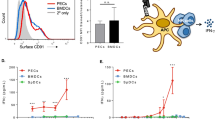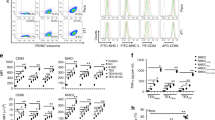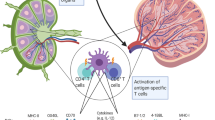Abstract
Heat-shock protein (HSP)-based immunotherapy is established on its adjuvant effects when applied via an extracellular approach to pulse and activate dendritic cells (DCs). Our previous studies indicate that DCs pulsed with recombinant fusion proteins of antigenic fragment and HSP70-like protein 1 (HSP70L1) are potent in stimulating antigen-specific Th1 responses. We herein evaluated the cytotoxic T cell (CTL) response by an intracellular approach of priming DCs with transfection of recombinant adenovirus-expressing the fusion gene of the 576–699 fragment of carcinoembryonic antigen (CEA) and HSP70L1. As compared with DCs pulsed with extracellular fusion protein, the DCs transfected with recombinant adenovirus expressing the fusion gene displayed equivalent mature phenotypes but less inflammatory appearance. However, the transfected DCs were superior to the pulsed DCs in inducing CEA-specific CTLs. Consistently, immunization of HLA-A2.1/H-2Kb transgene mice with the transfected DCs could induce more quantities of HLA-A2.1-restricted CEA-specific CTLs, protecting nude mice more significantly from human CEA-expressing colon tumor challenge when adoptively transferred. Mechanistic investigation indicated that intracellular expression of the fusion protein empowered the transfected DCs by activation of STAT1 possibly via inducing IFN-β and ERK pathways. Therefore, the more potent ability to induce anti-CEA CTL responses enables the DCs, which transfected with recombinant adenovirus expressing the fusion gene of antigenic CEA fragment and Th1 adjuvant, as an alternative promising approach for the immunotherapy of CEA-positive tumors.
This is a preview of subscription content, access via your institution
Access options
Subscribe to this journal
Receive 12 digital issues and online access to articles
$119.00 per year
only $9.92 per issue
Buy this article
- Purchase on Springer Link
- Instant access to full article PDF
Prices may be subject to local taxes which are calculated during checkout





Similar content being viewed by others
Change history
26 November 2019
"An amendment to this paper has been published and can be accessed via a link at the top of the paper."
References
Doyle SM, Genest O, Wickner S . Protein rescue from aggregates by powerful molecular chaperone machines. Nat Rev Mol Cell Biol 2013; 14: 617–629.
Kültz D . Molecular and evolutionary basis of the cellular stress response. Annu Rev Physiol 2005; 67: 225–257.
Saibil H . Chaperone machines for protein folding, unfolding and disaggregation. Nat Rev Mol Cell Biol 2013; 14: 630–642.
Kampinga HH, Craig EA . The HSP70 chaperone machinery: J proteins as drivers of functional specificity. Nat Rev Mol Cell Biol 2010; 11: 579–592.
Baker-LePain JC, Sarzotti M, Nicchitta CV . Glucose-regulated protein 94/glycoprotein 96 elicits bystander activation of CD4+ T cell Th1 cytokine production in vivo. J Immunol 2004; 172: 4195–4203.
Tanaka T, Okuya K, Kutomi G, Takaya A, Kajiwara T, Kanaseki T et al. Heat shock protein 90 targets a chaperoned peptide to the static early endosome for efficient cross-presentation by human dendritic cells. Cancer Sci 2015; 106: 18–24.
Gong J, Zhang Y, Durfee J, Weng D, Liu C, Koido S et al. A heat shock protein 70-based vaccine with enhanced immunogenicity for clinical use. J Immunol 2010; 184: 488–496.
Jung ID, Shin SJ, Lee MG, Kang TH, Han HD, Lee SJ et al. Enhancement of tumor-specific T cell-mediated immunity in dendritic cell-based vaccines by Mycobacterium tuberculosis heat shock protein X. J Immunol 2014; 193: 1233–1245.
Valentinis B, Capobianco A, Esposito F, Bianchi A, Rovere-Querini P, Manfredi AA et al. Human recombinant heat shock protein 70 affects the maturation pathways of dendritic cells in vitro and has an in vivo adjuvant activity. J Leukoc Biol 2008; 84: 199–206.
Binder RJ . Functions of heat shock proteins in pathways of the innate and adaptive immune system. J Immunol 2014; 193: 5765–5771.
Vabulas RM, Braedel S, Hilf N, Singh-Jasuja H, Herter S, Ahmad-Nejad P et al. The endoplasmic reticulum-resident heat shock protein Gp96 activates dendritic cells via the Toll-like receptor 2/4 pathway. J Biol chem 2002; 277: 20847–20853.
Saito K, Kukita K, Kutomi G, Okuya K, Asanuma H, Tabeya T et al. Heat shock protein 90 associates with Toll-like receptors 7/9 and mediates self-nucleic acid recognition in SLE. Eur J Immunol 2015; 45: 2028–2041.
Gong J, Zhu B, Murshid A, Adachi H, Song B, Lee A et al. T cell activation by heat shock protein 70 vaccine requires TLR signaling and scavenger receptor expressed by endothelial cells-1. J Immunol 2009; 183: 3092–3098.
Singh-Jasuja H, Toes RE, Spee P, Münz C, Hilf N, Schoenberger SP et al. Cross-presentation of glycoprotein 96-associated antigens on major histocompatibility complex class I molecules requires receptor-mediated endocytosis. J Exp Med 2000; 191: 1965–1974.
Basu S, Binder RJ, Ramalingam T, Srivastava PK . CD91 is a common receptor for heat shock proteins gp96, hsp90, hsp70, and calreticulin. Immunity 2001; 14: 303–313.
Xie J, Zhu H, Guo L, Ruan Y, Wang L, Sun L et al. Lectin-like oxidized low-density lipoprotein receptor-1 delivers heat shock protein 60-fused antigen into the MHC class I presentation pathway. J Immunol 2010; 185: 2306–2313.
Jockheck-Clark AR, Bowers EV, Totonchy MB, Neubauer J, Pizzo SV, Nicchitta CV . Re-examination of CD91 function in GRP94 (glycoprotein 96) surface binding, uptake, and peptide cross-presentation. J Immunol 2010; 185: 6819–6830.
Pawaria S, Binder RJ . CD91-dependent programming of T-helper cell responses following heat shock protein immunization. Nat Commun 2011; 2: 521.
Imai T, Kato Y, Kajiwara C, Mizukami S, Ishige I, Ichiyanagi T et al. Heat shock protein 90 (HSP90) contributes to cytosolic translocation of extracellular antigen for cross-presentation by dendritic cells. Proc Natl Acad Sci USA 2011; 108: 16363–16368.
Ichiyanagi T, Imai T, Kajiwara C, Mizukami S, Nakai A, Nakayama T et al. Essential role of endogenous heat shock protein 90 of dendritic cells in antigen cross-presentation. J Immunol 2010; 185: 2693–2700.
Ampie L, Choy W, Lamano JB, Fakurnejad S, Bloch O, Parsa AT . Heat shock protein vaccines against glioblastoma: from bench to bedside. J Neurooncol 2015; 123: 441–448.
Zhang Y, Zhang Y, Chen J, Liu Y, Luo W . Dendritic-tumor fusion cells derived heat shock protein70-peptide complex has enhanced immunogenicity. PLoS One 2015; 10: e0126075.
Zhou L, Zhu T, Ye X, Yang L, Wang B, Liang X et al. Long-term protection against human papillomavirus e7-positive tumor by a single vaccination of adeno-associated virus vectors encoding a fusion protein of inactivated e7 of human papillomavirus 16/18 and heat shock protein 70. Hum Gene Ther 2010; 21: 109–119.
Testori A, Richards J, Whitman E, Mann GB, Lutzky J, Camacho L et al. Phase III comparison of vitespen, an autologous tumor-derived heat shock protein gp96 peptide complex vaccine, with physician's choice of treatment for stage IV melanoma: the C-100-21 Study Group. J Clin Oncol 2008; 26: 955–962.
Tischer S, Basila M, Maecker-Kolhoff B, Immenschuh S, Oelke M, Blasczyk R et al. Heat shock protein 70/peptide complexes: potent mediators for the generation of antiviral T cells particularly with regard to low precursor frequencies. J Transl Med 2011; 9: 175.
Newman RG, Dee MJ, Malek TR, Podack ER, Levy RB . Heat shock protein vaccination and directed IL-2 therapy amplify tumor immunity rapidly following bone marrow transplantation in mice. Blood 2014; 123: 3045–3055.
Maeda Y, Yoshimura K, Matsui H, Shindo Y, Tamesa T, Tokumitsu Y et al. Dendritic cells transfected with heat-shock protein 70 messenger RNA for patients with hepatitis C virus-related hepatocellular carcinoma: a phase 1 dose escalation clinical trial. Cancer Immunol Immunother 2015; 64: 1047–1056.
Otto H, Conz C, Maier P, Wölfle T, Suzuki CK, Jenö P et al. The chaperones MPP11 and Hsp70L1 form the mammalian ribosome-associated complex. Proc Natl Acad Sci USA 2005; 102: 10064–10069.
Jaiswal H, Conz C, Otto H, Wölfle T, Fitzke E, Mayer MP et al. The chaperone network connected to human ribosome-associated complex. Mol Cell Biol 2011; 31: 1160–1173.
Leidig C, Bange G, Kopp J, Amlacher S, Aravind A, Wickles S et al. Structural characterization of a eukaryotic chaperone—the ribosome-associated complex. Nat Struct Mol Biol 2013; 20: 23–28.
Wan T, Zhou X, chen G, An H, chen T, Zhang W et al. Novel heat shock protein Hsp70L1 activates dendritic cells and acts as a Th1 polarizing adjuvant. Blood 2004; 103: 1747–1754.
Fang H, Wu Y, Huang X, Wang W, Ang B, Cao X et al. Toll-like receptor 4 (TLR4) is essential for Hsp70-like protein 1 (HSP70L1) to activate dendritic cells and induce Th1 response. J Biol chem 2011; 286: 30393–30400.
Fu Q, Wu Y, Yan F, Wang N, Wang W, Cao X et al. Efficient induction of a Her2-specific anti-tumor response by dendritic cells pulsed with a Hsp70L1-Her2(341-456) fusion protein. Cell Mol Immunol 2011; 8: 424–432.
Fang H, Ang B, Xu X, Huang X, Wu Y, Sun Y et al. TLR4 is essential for dendritic cell activation and anti-tumor T-cell response enhancement by DAMPs released from chemically stressed cancer cells. Cell Mol Immunol 2014; 11: 150–159.
Wu Y, Wan T, Zhou X, Wang B, Yang F, Li N et al. Hsp70-like protein 1 fusion protein enhances induction of carcinoembryonic antigen-specific CD8+ CTL response by dendritic cell vaccine. Cancer Res 2005; 65: 4947–4954.
Lam E, Stein S, Falck-Pedersen E . Adenovirus detection by the cGAS/STING/TBK1 DNA sensing cascade. J Virol 2014; 88: 974–981.
De Simone V, Franzè E, Ronchetti G, Colantoni A, Fantini MC, Di Fusco D et al. Th17-type cytokines, IL-6 and TNF-α synergistically activate STAT3 and NF-kB to promote colorectal cancer cell growth. Oncogene 2015; 34: 3493–3503.
Malanga D, De Marco C, Guerriero I, Colelli F, Rinaldo N, Scrima M et al. The Akt1/IL-6/STAT3 pathway regulates growth of lung tumor initiating cells. Oncotarget 2015; 6: 42667–42686.
Deng Z, Mu J, Tseng M, Wattenberg B, Zhuang X, Egilmez NK et al. Enterobacteria-secreted particles induce production of exosome-like S1P-containing particles by intestinal epithelium to drive Th17-mediated tumorigenesis. Nat Commun 2015; 6: 6956.
Wu L, Chen X, Zhao J, Martin B, Zepp JA, Ko JS et al. A novel IL-17 signaling pathway controlling keratinocyte proliferation and tumorigenesis via the TRAF4-ERK5 axis. J Exp Med 2015; 212: 1571–1587.
Acknowledgements
We thank Drs Chaofeng Han, Meng Xia and Kun Chen for technical assistance. This work was supported by grants from the National High-Tech Projects (2012AA020808 and 2007AA021003).
Author information
Authors and Affiliations
Corresponding authors
Ethics declarations
Competing interests
The authors declare no conflict of interest.
Additional information
Supplementary Information for this article can be found on the Cellular & Molecular Immunology website
Supplementary information
Rights and permissions
About this article
Cite this article
Liu, S., Yi, L., Ling, M. et al. HSP70L1-mediated intracellular priming of dendritic cell vaccination induces more potent CTL response against cancer. Cell Mol Immunol 15, 135–145 (2018). https://doi.org/10.1038/cmi.2016.33
Received:
Revised:
Accepted:
Published:
Issue Date:
DOI: https://doi.org/10.1038/cmi.2016.33
Keywords
This article is cited by
-
Dendritic cell migration in inflammation and immunity
Cellular & Molecular Immunology (2021)
-
Intracellular HSP70L1 inhibits human dendritic cell maturation by promoting suppressive H3K27me3 and H2AK119Ub1 histone modifications
Cellular & Molecular Immunology (2020)
-
A modified HLA-A*0201-restricted CTL epitope from human oncoprotein (hPEBP4) induces more efficient antitumor responses
Cellular & Molecular Immunology (2018)



